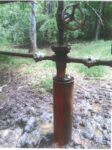Are you a mineral owner with a gas well on your mineral tract and 1) you are getting a flat rate royalty check but don’t think the well is actually producing, or 2) you are getting a “shut in” check and think the well is really exhausted and will never produce gas in “paying quantities” again, or 3) you are getting a really tiny 1/8th or other royalty and so you do not think it is producing in “paying quantities”?
Are you a surface-only owner with a non-producing well on your land? If so, you may be worried about its old down-hole casing going bad and polluting your groundwater. (Contamination can come from the target gas formation, from other gas formations above that, from surface runoff down the well, from the mixing of water from good groundwater strata with water from iron or sulphur groundwater strata.)
If so and you are a mineral owner, you maybe be able to get the well plugged or to get the lease otherwise terminated so you can keep them from drilling new wells on you (because you are also the surface owner), or so you can get a new better lease from another driller who will drill a more productive well.
If so and you are the surface owner, there may be a way to get the well plugged to protect your land.
This article will suggest three strategies. Note that this article was originally written for mineral owners who want to free up their mineral tracts for new leases (and for mineral tract owners who are also surface owners and want no new wells drilled on them). However, the first strategy also works for the purposes of the people who only own the surface and just want the dangerous old well plugged. If that first strategy does not work for a surface owner, it may be that a lawyer with experience in oil and gas can think of another strategy for a surface owner. (Note also that there is a chance that stirring the pot may make the driller who owns the lease being held by the well on the surface owner’s land to drill on this mineral tract with a new well sooner than they otherwise planned to – but we think that risk is small. Drillers drill first where they think they can get the most gas out without much consideration for surface owners’ concerns.)
Before a mineral owner should start on any strategy, check and make sure that you know all the wells that were drilled on all the acres included in the old lease that covers your acres. Ask the company, walk the land, check on-line well maps, compare well names on DEP’s Office of Oil and Gas website etc. [Note that sometimes, the mineral tract that was leased gets partitioned. In that situation, unless the lease says different (and many do – having something called an sometimes called an entireties clause) you only get royalty if the well is drilled on your partitioned subdivision of the acres. Unfortunately the law says that any well on the original lease tract holds the entire original tract even though the royalty is getting paid to someone who owns a different subdivision – an issue someone should take to the Supreme Court and get fixed.]
Get the numbers of the well(s) in question. The company’s number should be on your flat rate royalty/shut in check stub. The API number, not the company number, works best. The API number looks like a social security number and should be marked on the well, or the company sending you the checks might tell you the API number if you call and give them their information off the check stub.
First strategy — try using the State. Using the numbers you can find for all the wells on the lease (if you are a mineral owner) or the well on your property (if you are the surface owner), call the DEP/OOG (or use their web site and see whether the driller has reported production for any of the wells for the last 12 months. If so, you are probably stuck, but if you are a mineral tract owner, you might take the well number and data you have gotten, and the lease if you have it, and see a knowledgeable oil and gas lawyer. That lawyer can see if there is a way out for some of your lease acreage under an implied covenant of further development or exploration.
If there has been no production for 12 months on any wells on your lease, see if DEP/OOG have the well(s) status listed as “abandoned well”. You can call or use their web site. If so, complain to the DEP that DEP should make the operator plug the well(s). Because the OOG is so understaffed, they are not generally making the drillers plug any wells at this time. They are running 5,000 wells behind and the backlog is only likely to get worse. But if someone calls and complains, they might take action. (Note that if the well is not listed as “abandoned” even though it is not producing, the operator might be claiming a “bona fide future use” for the well. You might ask the OOG for that document for the well(s) in question and see if it is correct. If it is not, the State might change the status to abandoned and make the operator plug the oil or gas well. This trick will help both mineral tract owners and surface owners)
Second strategy — if using the State does not work, or you decide the chances of success are not worth the hassle, you as a mineral tract owner can try finding another driller to give you a lease. Even if DEP does not make the old driller plug it, a new driller may still give you a new lease. Find the drillers who are leasing or drilling in your area by asking around the courthouse record room or checking out the OOG website for drillers getting new permits, and ask their landmen. Different companies have different standards for when they will give you a new lease when there is an old company still claiming the old lease is still in effect. It may depend on how hot your area is or how little you are willing to take as a signing bonus. You will probably have to sign an affidavit regarding the inactivity of the well at the same time you sign any lease.
Third strategy — even if DEP does not make them plug the well, and even if you as a mineral tract owner cannot find a new company to lease, you may be able to free up the lease, but it’s time to see a lawyer. This is probably your only strategy if the well is still reporting minimal production that you think is not in “paying quantities” because the driller is willing to produce the well at a loss just to hold the lease. (Take the reported production number and multiply it by about $4.00 and see if you think the result is enough to pay their costs of keeping the well in production.) You need to find a lawyer who knows oil and gas law to have that lawyer analyze the situation and recommend and assist with the appropriate action. This is only likely to be worth your while if you want to terminate the old lease so that no driller will have a lease to drill on your property, or if you are in a hot area and are sure you can get a new driller to lease.
Finally, any of these three strategies, even if you just start using one, may get the existing driller to give up and release the current lease with or without plugging the well, or to agree to a new lease with better terms. That will depend on how much they want to hold on to the lease in an area that is not hot, or what having a lease for your property is worth to them in a hot area.
Links:




